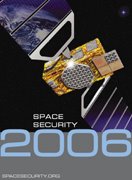7.10.2006
Not Necessarily Beach Reading
 Just in time for the beach . . . or not?
Just in time for the beach . . . or not?The Space Security Index, "a research partnership between several academic, governmental, and non-governmental organizations, who together make up the consortium, Spacesecurity.org" -- and yes, partners include the Institute of Air and Space Law at McGill University, along with Project Ploughshares, the Simons Centre for Disarmament and Non-Proliferation Research at the University of British Columbia, and the Space Generation Foundation -- have released their 1.2 MB publication, Space Security 2006 (July 2006).
(Or, if you prefer, and at this time of year I typically do, the executive summary.)
For those unfamiliar with the project, here is some background:
Space Security 2006 aims to provide a comprehensive and integrated assessment of the state of space security. It is the third such annual evaluation of space security, which for these purposes is defined as the secure and sustainable access to and use of space, and freedom from spacebased threats. The report examines international developments in space security according to eight indicators, providing a comprehensive overview of the concerns of military, civilian, and commercial space stakeholders from around the world.
This project accepts the position that space is a global commons, as enshrined in the 1967 Outer Space Treaty, bordering every community on Earth. There is no doubt that national and international security dynamics on Earth and space security are interlinked: space systems can enhance national security by providing transparency and by supporting military operations and international security concerns on Earth risk spilling over into the space environment.
However, our approach posits that there are policies that can enhance the security of all actors in space. Space security need not be a zero-sum game but instead can be a path to prosperity and a path to peace.
The pursuit of space security is plagued by certain contradictions. For example, the acquisition of independent space access by more actors could aggravate environmental concerns in space. Technologies that enable more effective use of space for some often have the inherent potential to negate the secure use of space for others. Indeed, the same assets used for space surveillance and collision avoidance could provide precision targeting of space assets. These contradictions are commonly interpreted from the national security vantage points of individual space actors. However, these concerns need to be explored and collectively managed, and, by their very nature, require a common understanding of space security. We expect this report will provide food for thought in this regard. It is our hope that Space Security 2006 will improve the transparency.
And FYI, those "eight indicators" are:
A heafty undertaking. I personally know a lawyer who is at the office downloading the report at this moment. Of course for others, this sort of thing may be just too hardcore for under the sun umbrella drinking frozen Margaritas. Up to you.
Pass the chips?






